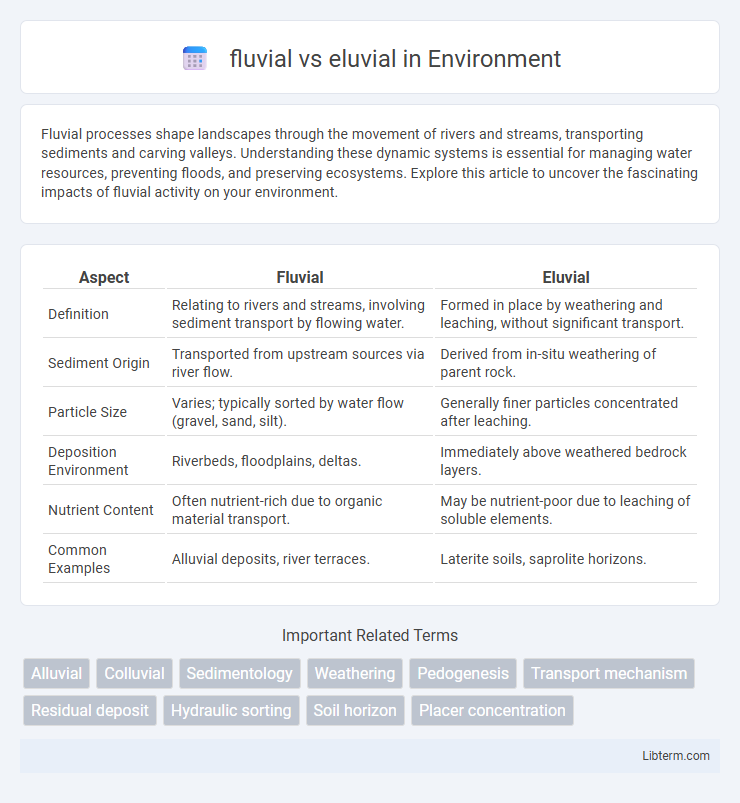Fluvial processes shape landscapes through the movement of rivers and streams, transporting sediments and carving valleys. Understanding these dynamic systems is essential for managing water resources, preventing floods, and preserving ecosystems. Explore this article to uncover the fascinating impacts of fluvial activity on your environment.
Table of Comparison
| Aspect | Fluvial | Eluvial |
|---|---|---|
| Definition | Relating to rivers and streams, involving sediment transport by flowing water. | Formed in place by weathering and leaching, without significant transport. |
| Sediment Origin | Transported from upstream sources via river flow. | Derived from in-situ weathering of parent rock. |
| Particle Size | Varies; typically sorted by water flow (gravel, sand, silt). | Generally finer particles concentrated after leaching. |
| Deposition Environment | Riverbeds, floodplains, deltas. | Immediately above weathered bedrock layers. |
| Nutrient Content | Often nutrient-rich due to organic material transport. | May be nutrient-poor due to leaching of soluble elements. |
| Common Examples | Alluvial deposits, river terraces. | Laterite soils, saprolite horizons. |
Introduction to Fluvial and Eluvial Processes
Fluvial processes involve the transportation and deposition of sediments by running water, typically in rivers and streams, shaping landscapes through erosion and sedimentation. Eluvial processes refer to the in-situ weathering and removal of mineral components from soils or rocks without significant transport by water, leading to concentration of residual materials. Understanding the distinction between fluvial and eluvial mechanisms is essential for analyzing sediment provenance, soil formation, and landscape evolution.
Defining Fluvial Deposits
Fluvial deposits consist of sediments transported and laid down by river and stream waters, characterized by well-sorted sands, gravels, and silts that reflect dynamic water flow environments. These deposits often exhibit stratification, rounded particles, and channel structures indicative of continuous sediment redistribution in alluvial plains, floodplains, and riverbeds. Fluvial deposits are crucial in reconstructing paleoenvironments and serve as significant aquifers and reservoirs for natural resources.
Understanding Eluvial Deposits
Eluvial deposits form through the in-situ weathering and leaching of minerals within the soil or rock, resulting in the concentration of resistant materials like gold or iron oxides. These deposits lack significant transportation by water, distinguishing them from fluvial deposits, which are transported and deposited by river action. Understanding eluvial deposits is crucial for mineral exploration because their localized formation often indicates the primary source of valuable minerals.
Key Differences Between Fluvial and Eluvial
Fluvial deposits form through the transportation and sedimentation by running water, resulting in well-sorted, rounded particles often found in river beds and floodplains. Eluvial deposits develop in place through the weathering and leaching of rocks, leading to poorly sorted materials with angular fragments typically located on hillslopes or beneath exposed rock outcrops. The main difference lies in fluvial deposits being transported sediments, while eluvial deposits remain near their original source due to in-situ weathering processes.
Formation Mechanisms of Fluvial Deposits
Fluvial deposits form through the action of running water in rivers and streams, where sediment is transported, sorted, and deposited based on flow velocity and sediment size. These deposits typically exhibit stratification, cross-bedding, and well-sorted sand, gravel, or silt layers shaped by hydraulic processes such as erosion, suspension, and traction. In contrast, eluvial deposits originate from in situ weathering and mineral breakdown, with minimal transport, resulting in residual soils rich in insoluble materials like clay and oxides.
Eluvial Formation and Environmental Conditions
Eluvial formation occurs through the in-place weathering and leaching of soil or rock, leading to the concentration of resistant minerals while soluble components are removed. This process typically takes place under stable environmental conditions with minimal water runoff, promoting the vertical movement of materials rather than horizontal transportation. Eluvial deposits often form in humid to sub-humid climates where slow chemical weathering dominates and is crucial for enriching lateritic soils and certain mineral deposits.
Economic Importance of Fluvial vs. Eluvial Deposits
Fluvial deposits, formed by river and stream processes, often contain economically valuable alluvial gold, diamonds, and placer minerals, making them critical for mining industries. Eluvial deposits, created by weathering and decomposition in place, are significant for extracting minerals like tin, bauxite, or lateritic ores but typically have lower concentration compared to fluvial deposits. The higher resource concentration and ease of extraction from fluvial deposits generally result in greater economic importance for mining operations.
Typical Minerals Found in Fluvial versus Eluvial Contexts
Typical minerals found in fluvial contexts include quartz, feldspar, garnet, zircon, and heavy minerals like ilmenite and magnetite, transported and deposited by river currents. Eluvial deposits commonly contain weathering-resistant minerals such as kaolinite, goethite, hematite, and primary ores like bauxite, formed in situ through chemical weathering processes. The mineral assemblage differences reflect transport dynamics and depositional environment, with fluvial minerals often showing rounded grain textures compared to the more angular and weathered minerals in eluvial deposits.
Exploration Techniques for Fluvial and Eluvial Resources
Exploration techniques for fluvial resources prioritize sediment sampling, channel mapping, and geophysical surveys to identify alluvial deposits in riverbeds and floodplains. In contrast, eluvial resource exploration relies heavily on surface geochemical sampling and detailed soil profile analysis to detect mineral concentrations weathered directly from bedrock. Remote sensing technology and GIS mapping enhance targeting precision in both contexts, optimizing resource evaluation and extraction planning.
Summary: Choosing Between Fluvial and Eluvial for Resource Development
Fluvial deposits, formed by river and stream activity, often contain well-sorted, larger particles such as sand and gravel, making them ideal for aggregate mining and high-permeability resource extraction. Eluvial deposits result from weathering and in situ concentration of minerals on-site, yielding high-purity materials like gold and tin, but with lower transport and sorting effects compared to fluvial systems. Selecting between fluvial and eluvial sources depends on the target resource type, deposit accessibility, and environmental impact considerations for efficient resource development.
fluvial Infographic

 libterm.com
libterm.com